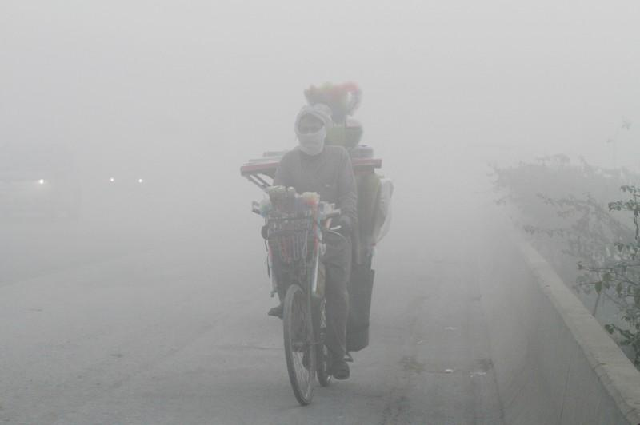Lahore’s ‘airpocalypse’
This alarming smog situation is not a new phenomenon, nor does it come without warning

A man rides a bicycle on a smoggy morning in Lahore. PHOTO: Reuters
The air pollution in many areas of Punjab, especially Lahore, is bad throughout the year. In the winter months, however, the phenomenon of temperature inversion, whereby warmer air rises and traps colder air below it, exacerbates pollution levels, and ushers in the “smog” season.
With similar – and at times even more severe – air pollution levels, New Delhi has declared a public environmental emergency with schools being temporarily shut down, and cars with number plates with either odd or even numbers being allowed to ply the roads on a given day.
Even the Indian Supreme Court has sprung into action to try and address the hazardous air problem.
In the case of pollution on our side of the border, the response has been more lethargic. Our State Minister for Climate Change created quite a stir by dismissing concerns about smog as being exaggerated, and by primarily blaming Indian Punjab for aggravating the problem. Yet, Amnesty International has recently taken the Punjab government to task for its failure to address the smog problem, rightly describing this institutional apathy as a human rights violation.
A petition has also just been filed in the Lahore High Court by school children asking for judicial action to deal with smog. A Smog Commission was formed last year but its recommendations do not seem to have been taken seriously given that the smog situation this year seems as bad, if not worse than the preceding years. Yet, reliable data on air quality is still not being collected by the government.
Instead, we rely on data being made available through private entities. Contending with smog is not easy, and the factors responsible for it are also varied.
Smoke from bricks kiln, the burning of rice stubble and garbage, industrial pollution and a large-scale loss of trees due to an expanding network of roads city and more buildings, have all contributed to this problem.
However, the main culprit for the smog seems to be the transport sector. Crude oil refineries in Pakistan are producing substandard fuel, the quality of which is made worse due to adulteration, and lack of emissions testing of vehicles. But no real effort has been made to switch to higher quality fuel. No serious attempts have been made to institute emission testing of vehicles plying the roads. Instead of investing in flexible public transportation options, we have opted for grandiose projects, such as metro buses and unending road expansions.
Encouraging schools to use buses to transport children to and from school is also another option which has not received any attention. The provincial government lacks the resolve and capacity to curb industrial emissions, or to nudge the energy sector away from the use of coal to generate electricity.
Even the plan of only allowing brickmaking using zigzag technology in the future is not going to be easy, given the tough time state institutions have in preventing debt bondage in the brick kiln sector. Banning burning trash and plastic will also not work lest there is parallel investment in means to collect trash, and safely dispose and recycle it.
There is now a concerted attempt to rejuvenate and create new green spaces in the city, and to plant indigenous and endangered tree species by the Afforestation Lahore Project, and other similar efforts, which have brought together government agencies, civil society and the private sector.
It will, however, take some time for these efforts to make a visible impact on the smog situation in the city. Moreover, reforestation is not the answer for continuing to pollute with reckless abandon. We simultaneously need an urgent policy shift across Lahore, and its adjoining industrial and agricultural areas, to effectively monitor and curb air pollution, which is presently wreaking havoc on the health of millions of people.
















COMMENTS
Comments are moderated and generally will be posted if they are on-topic and not abusive.
For more information, please see our Comments FAQ